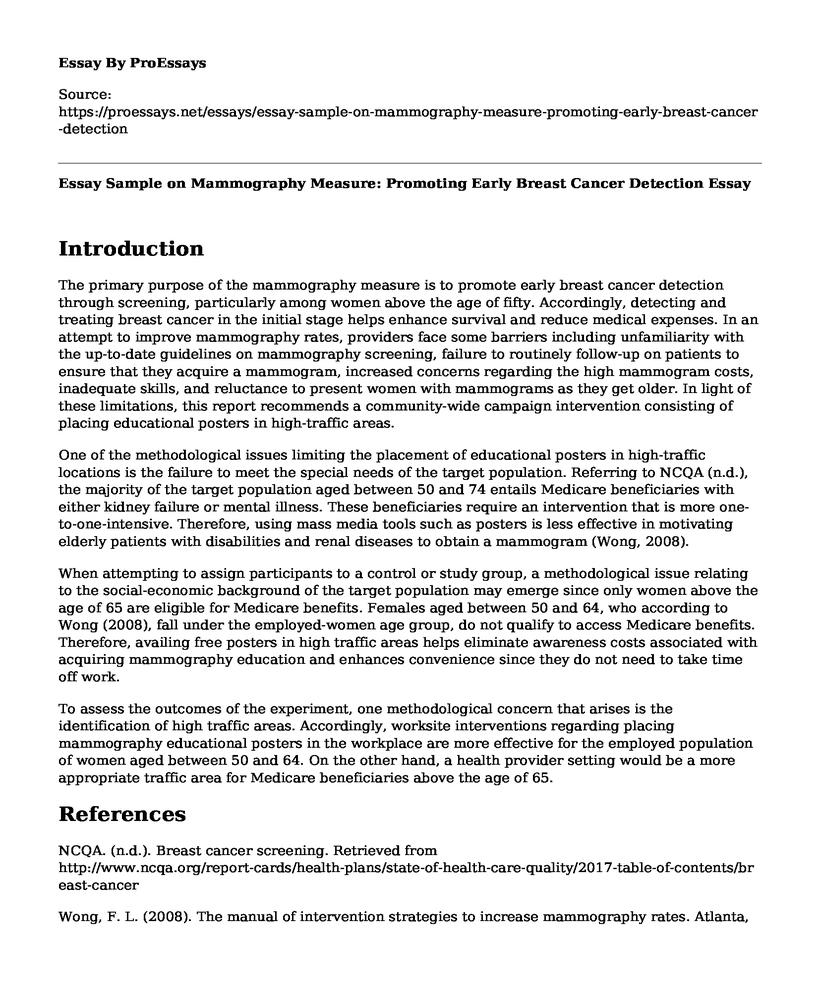Introduction
The primary purpose of the mammography measure is to promote early breast cancer detection through screening, particularly among women above the age of fifty. Accordingly, detecting and treating breast cancer in the initial stage helps enhance survival and reduce medical expenses. In an attempt to improve mammography rates, providers face some barriers including unfamiliarity with the up-to-date guidelines on mammography screening, failure to routinely follow-up on patients to ensure that they acquire a mammogram, increased concerns regarding the high mammogram costs, inadequate skills, and reluctance to present women with mammograms as they get older. In light of these limitations, this report recommends a community-wide campaign intervention consisting of placing educational posters in high-traffic areas.
One of the methodological issues limiting the placement of educational posters in high-traffic locations is the failure to meet the special needs of the target population. Referring to NCQA (n.d.), the majority of the target population aged between 50 and 74 entails Medicare beneficiaries with either kidney failure or mental illness. These beneficiaries require an intervention that is more one-to-one-intensive. Therefore, using mass media tools such as posters is less effective in motivating elderly patients with disabilities and renal diseases to obtain a mammogram (Wong, 2008).
When attempting to assign participants to a control or study group, a methodological issue relating to the social-economic background of the target population may emerge since only women above the age of 65 are eligible for Medicare benefits. Females aged between 50 and 64, who according to Wong (2008), fall under the employed-women age group, do not qualify to access Medicare benefits. Therefore, availing free posters in high traffic areas helps eliminate awareness costs associated with acquiring mammography education and enhances convenience since they do not need to take time off work.
To assess the outcomes of the experiment, one methodological concern that arises is the identification of high traffic areas. Accordingly, worksite interventions regarding placing mammography educational posters in the workplace are more effective for the employed population of women aged between 50 and 64. On the other hand, a health provider setting would be a more appropriate traffic area for Medicare beneficiaries above the age of 65.
References
NCQA. (n.d.). Breast cancer screening. Retrieved from http://www.ncqa.org/report-cards/health-plans/state-of-health-care-quality/2017-table-of-contents/breast-cancer
Wong, F. L. (2008). The manual of intervention strategies to increase mammography rates. Atlanta, GA: Centers for Disease Control and Prevention. Retrieved from https://www.cdc.gov/cancer/nbccedp/pdf/prumanual.pdf
Cite this page
Essay Sample on Mammography Measure: Promoting Early Breast Cancer Detection. (2023, Apr 08). Retrieved from https://proessays.net/essays/essay-sample-on-mammography-measure-promoting-early-breast-cancer-detection
If you are the original author of this essay and no longer wish to have it published on the ProEssays website, please click below to request its removal:
- Marketing Essay: Strategies to Maintain Market Share for a Pharmaceutical Company
- How the CIA Created AIDS Essay
- Treatment for Dementia - Research Paper
- Paper Example on Cannabidiol
- Essay Sample on Transforming Global Health
- Essay on Nurse Practitioners Need Cultural Awareness Training to Provide Quality Care
- Nurses in Australia: Ethics, Morals & Stipulated Rules for Protection - Essay Sample







